Or your green truck and water towers. Rachel Maxi‘s tiny oil paintings studio sale on Dec. 10, 4-8 p.m., lubricated with wine and fortified with cheese. 1326 13th Ave. S. Seattle, 98144.
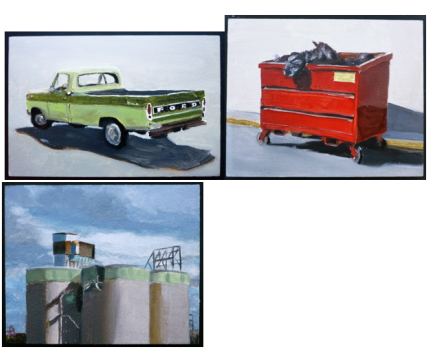
Regina Hackett takes her Art to Go
Or your green truck and water towers. Rachel Maxi‘s tiny oil paintings studio sale on Dec. 10, 4-8 p.m., lubricated with wine and fortified with cheese. 1326 13th Ave. S. Seattle, 98144.

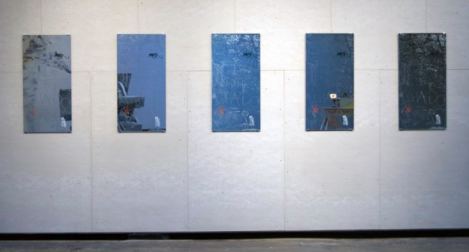 Everyone is an Artist, The Summit, 2009
Everyone is an Artist, The Summit, 2009
Acid etching and acrylic on mirror of an original taken
from The Summit Public House
36 x 18 inches
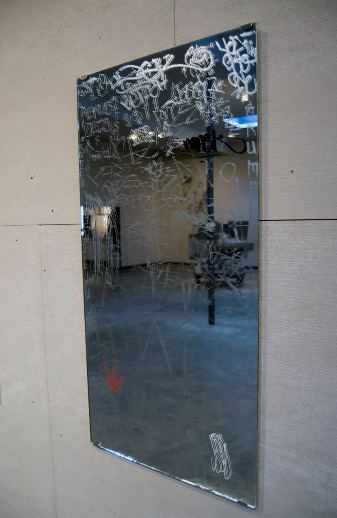 Tue Greenfort A Flies Composition, 2004
Tue Greenfort A Flies Composition, 2004
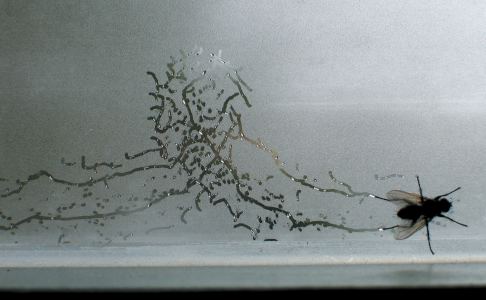
Caitlin Parker, from her series, Involuntary Parks (via)

The continent’s imperiled rims therefore become a new kind of landscape, the Involuntary Parks. They are not representations of untouched nature, but of vengeful nature, of natural processes reasserting themselves in areas of political and technological collapse. An embarrassment during the twentieth century, Involuntary Parks could become a somber necessity during the twenty-first.
Seattle critic Elizabeth Bryant tends to write about art at the margins of the Seattle experience. If she were in New York or LA, she’d find the less likely there too. Ditto North Dakota. Whatever is central in North Dakota would be unlikely to move her, but a North Dakota follower of Italian Futurism who paints in a sagging house off a rutted road and fails to notice that Futurism is a century past its pull date might well become the subject of her illuminated scrutiny.
Here she is on painter David Kane:
“Farewell to Mars and Other Paintings” is Kane’s first show “since all that happened,” (meaning his diagnosis, treatment, and recovery from lung and thyroid cancer…) Some of the canvases in the show were begun ten years ago, set aside and picked up again; others are entirely new. Allusions to the battle with cancer can be read throughout the show in saucers, moons and suns that look like cells, in the scorched earth and the struggle of flesh and technology.
In “Farewell to Mars”, a priapic alien herma gives a three-fingered wave to a trio of flying saucers soaring like so many platelets in the purple skies of a red planet. It’s a hopeful sign.
Kane’s painting, as always, is intellectually and pictorially brilliant, going far beyond the personal. He plays with spatial recession, atmospheric effects, and deceptively tight compositions, pulling from 18th-century Venetian vedute painters (think Canaletto), depression-era regionalism (think Benton and Hopper), ’50s pulp sci-fi illustration, and apocalyptic fundamentalist religious tracts (rapture merges with alien abduction) to reference classical myth and rationalism, post-war atomic-age conformity, environmental disaster, and the war-ravaged sands of the Middle East. (more)
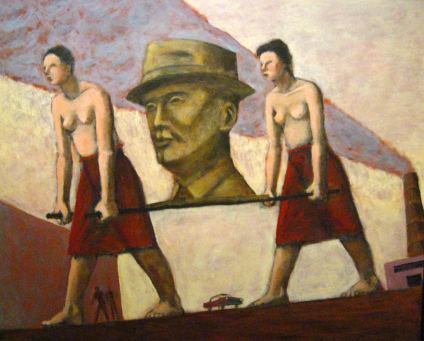 Canaletto? Not even a little bit. I can see Benton without the rhythm and Hopper without the light, however. Kane’s paintings look as if he made them with caked powders on sandpaper. In their choked aridities, in their coarse forms and muddy colors, there is something genuine, a real toad in his imaginary garden. Bryant is thunderously wrong in what she sees in him, but I enjoyed reading every word. She’s that rare critic who lives not because of her judgments but in spite of them.
Canaletto? Not even a little bit. I can see Benton without the rhythm and Hopper without the light, however. Kane’s paintings look as if he made them with caked powders on sandpaper. In their choked aridities, in their coarse forms and muddy colors, there is something genuine, a real toad in his imaginary garden. Bryant is thunderously wrong in what she sees in him, but I enjoyed reading every word. She’s that rare critic who lives not because of her judgments but in spite of them.
The great Elliott Bay Book Company got the obit it deserved not from any Seattle source, but from Kim Murphy in the LA Times, here. Murphy’s story suffers under a stupid headline – The plot thickens for a legendary bookstore – which, of course, Murphy didn’t write. The plot’s not thickening. It’s losing its narrative runway.
The usual Seattle sources covered it, but not well.
Paul
Constant at the Stranger was more interested in griping that he didn’t
get full credit from the Seattle Times for being first as the news
breaker. (Constant was much better on the demise of Bailey/Coy Books, which like the Stranger is on Capitol Hill. Bailey/Coy is a lovely little store, but compared to Elliott Bay, its significance is tiny.)
The
online Seattle Post-Intelligencer, a ghost of its former self, has no
interest in culture. Is the Seattle Times being written from Seattle? Its story
on Elliott Bay’s economic impact to Pioneer Square’s arts presence missed the
Square’s essential cultural identity. Besides being a haven for readers
thanks to Elliott Bay, that’s where nearly all of the city’s major art
galleries are located.
On Crosscut, Knute Berger was better than the ST on the economic impact, but again, does he live here?
Berger:
If
the blend of street life in Pioneer Square is largely the homeless, bar
patrons, and seasonal tourists, add to that mix sports fans, not
necessarily a book-buying crowd.
Galleries, big guy, galleries. The visual art crowd hits those streets, Tuesdays through Saturdays.
What
difference does it make? Anyone who’s interested has heard the news:
Elliott Bay is either going down or moving to Capitol Hill . That’s
where the LA Times’ story comes in. What is the character of this
particular store? Breath and depth, ladies and gentlemen. Breath and
depth.
OTHER NEWS….
Put on a happy face: The best graphic for Art/Basel/Miami Beach, opening Wednesday, comes from C-Monster, here.
(“Miami, Where Art Sweats. From the Department of Public Relations and
Extra Marital Affairs.”) Enough with the sobbing. Make it work.
Shudder: The Art World Edition of 7 Habits of Highly Effective People here. I remember when everyone at the Seattle Times was required to read 7 Habits,
and I (once again) gave thanks that I worked at the PI. The PI’s unruly
newsroom would have dropped kicked that order into a dumpster.
Richard Lacayo is pulling the plug on his excellent blog, Looking Around.
Why? Maintaining a one-person blog of that quality is a lot of work.
Missing from Lacayo’s sign-off is any acknowledgment that his blog made
him. He had worked for Time for decades and was largely ignored, except
in architectural criticism circles, laboring as he was under the large
shadow of Robert Hughes. With Looking Around, he became a
national figure. Here’s hoping his reasonable and intelligent voice
continues to be prominent once dropped back into the Time pool. (Who
reads Time? Ever? Anybody?)
From Kenneth Baker, why what art critics see at major exhibitions is different than anyone else, here.
Congratulations! Seattle’s Jen Graves wins a Warhol grant, here. (Other winners here.)
Stuart Sherman is back, here.
When an artist such as Sherman dies neglected and remains neglected, it
is a sign that the art world being driven by the market. His
reemergence means the opposite. Maybe the recession is not all bad.
Houston’s Douglas Britt loves Dario Robleto, here.
Britt goes the extra mile for his home town hero, traveling on his own
dime to see Robleto shows beyond Texas, including one in Seattle.
Private property is (art) theft, here.
Buying the land on which a key Richard Serra rests shouldn’t mean you
get to wreck it through neglect and deny access to the public. Tyler Green reports that at least the owners won’t be able to demolish it, here.
Kyle MacMillan does a fine job of saying goodbye to the retiring director of the Denver Art Museum, here.
Alexandra Silverthorne has a fresh approach to litter left in a park, here. (Love the white plastic spoon in the bushes.)
an ArtsJournal blog


